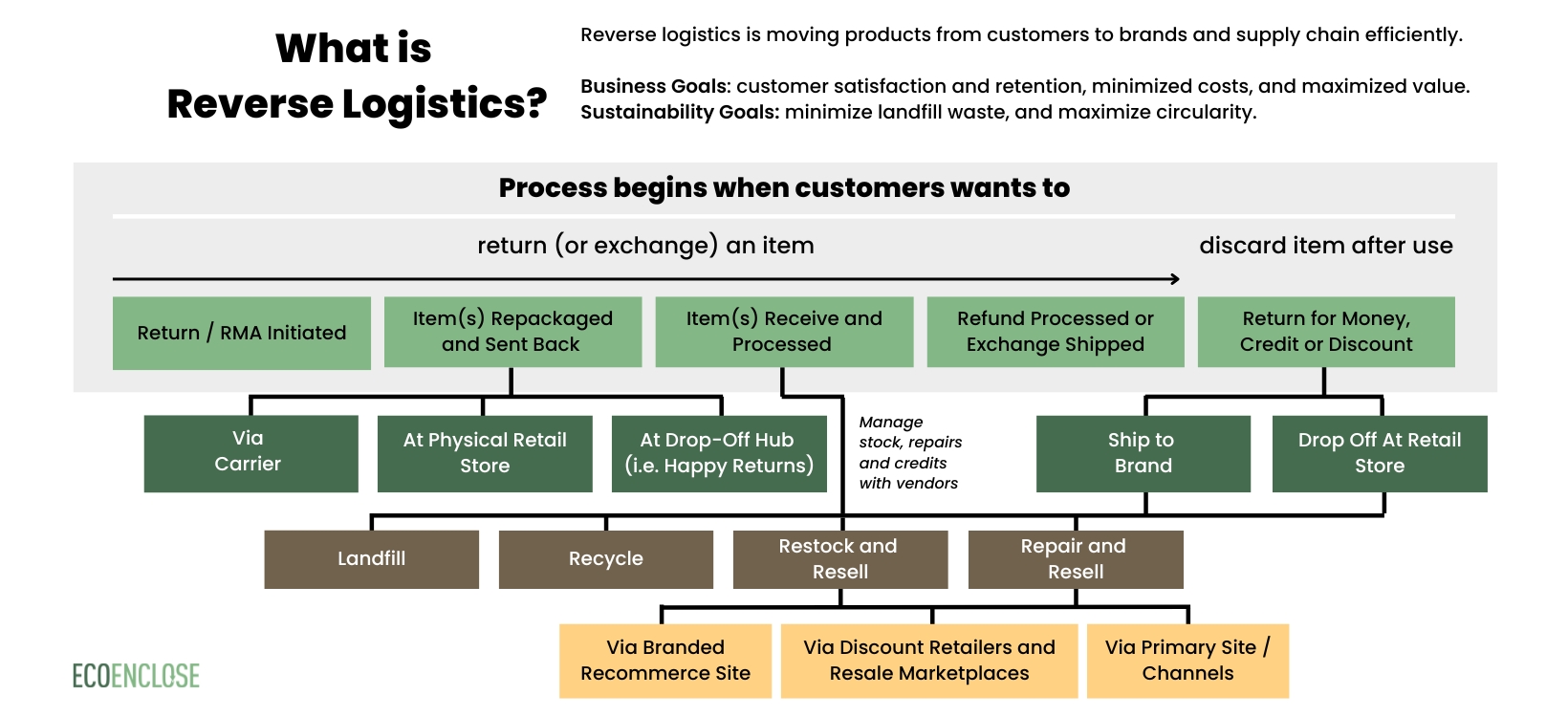Reverse Logistics Companies and Strategies: How to Optimize Your Return Process
Posted By on Oct 17th 2024
Reverse Logistics, Returns and Recommerce
Reverse logistics is an important consideration in any eCommerce business. You must cultivate robust and scalable strategies that allow customers to easily and conveniently return a product.
Small and medium businesses typically do not have the resources to compete with the reverse logistics of big eCommerce brands like Amazon. Luckily, there are a few reverse logistics companies that can help. Here are some examples of return strategies and reverse logistics companies that can elevate your return policy to big brand levels.
What are reverse logistics and recommerce?
Reverse logistics is a type of supply chain management that focuses on moving goods from customers back to retailers, often as returns. The idea may seem simple, but it’s not as straightforward as forward logistics. It has far more considerations, including product resell and repair, processing refunds or store credit, and more. eCommerce adds additional barriers, as you must work with your carriers to retrieve the product from your customers.
What is recommerce?
Recommerce, derived from “reverse commerce,” describes selling previously owned items to buyers who reuse, recycle, or resell them. Because the term “reverse logistics” is sometimes used to describe how customers recycle or resell their goods, we include recommerce as an important component of reverse logistics.

The many R’s of reverse logistics and recommerce
Although people like to put reverse logistics into a neat little package of 5 R’s, there are actually many R’s to consider. Here are some of the most important ones.
- Return policy: You must first develop a return policy that protects your brand, satisfies your customers, and keeps sustainability in mind. Consider which situations you’ll offer a full refund and when store credit is suitable. Determine whether you’ll foot the delivery bill or if that will be up to your customer. Choose reusable packaging that makes returns less wasteful.
- Reselling: If the item comes back in great condition, brands can hopefully restock it, add it to their inventory, and sell it again. Create quality assurance strategies to help you determine if a product can be resold and when it needs to be repaired or recycled.
- Repairing: Many returns are due to faulty products or damaged goods. In this situation, the optimal step is to repair the item quickly and then resold.
- Recycling: When repairing and reselling isn’t viable, the next best alternative is recycling the product.
- Recapturing/retaining customers through exchanges: The returned product is ideally resold, repaired, or recycled, but brands should also consider customer satisfaction. A fair return policy helps with this, but you can take additional steps through discounts on future purchases or other promotions to retain business.
- Recommerce (which includes buybacks, refurbishments, and trade-ins): Often, a brand's products outlast their consumers’ upgrade cycles. Many individuals purchase apparel, electronics, and other categories of goods, and decide to stop using them well before reaching the end of their useful life. These items can be resold rather than landfilled or recycled.
Reverse logistics examples
Here are some examples of how brands bring innovation, sustainability, and values-oriented thinking to the reverse logistics process.
Branded recommerce platforms
Examples: Eileen Fisher Renew, Patagonia Worn Wear, Timberloop,
The most forward-thinking brands are building circularity and recommerce into the fabric of their companies. Patagonia Worn Wear is arguably the OG in this space, but many other conscious brands have similar programs. For example, Eileen Fisher Renew allows shoppers to return their wearable Eileen Fisher clothing to be inspected, laundered, and resold as part of their Renew platform. Timberloop is Timberland’s recommerce platform, allowing worn Timberland goods to be donated back (for a 10% discount on a future Timberland order). Items are either resold, refurbished, and resold or recycled back into new textiles.
Brand and retailer-led refurbishing and reselling
Example: Mobile operators and electronics OEMS
While branded recommerce platforms are still somewhat novel and untested, the concept of refurbishing goods and selling them on a second market has been around for some time.
Companies like Apple and Canon have offered trade-in programs for decades that enable users to sell back their used products in exchange for credit toward new items.
Mobile operators like Verizon, AT&T, and T-Mobile offer mobile device trade-in programs for a discount on upgraded devices or service plans. Best Buy and Target have programs that let consumers trade in used products for credit or discounts, including everything from electronics to car seats.
Cisco remanufactures goods such as phones, routers, and switches. GE Healthcare remanufactures imaging devices and ultrasound machines. Microsoft also has a large global initiative to deal with end-of-life issues for devices, batteries, and packaging.
Brand-led recycling initiatives
Example: Levi Strauss and For Days
Another great example of sustainable reverse logistics is recycling initiatives from the brands themselves. For Days is an amazing fashion brand that has established a Take Back Bag. Shoppers order the bag, fill it with their old garments, and send it back to For Days, which responsibly recycles the clothing.
Levi Strauss has its own branded recommerce platform—Levi’s SecondHand. But the brand has doubled down on its commitment to circularity. Consumers can return their denim to Levi’s, which will either be resold or recycled black into jeans.
Levi’s circular 501® jeans, made with a blend of certified organic cotton and Renewcell’s pioneering Circulose® fiber, remove pollutive elements that would otherwise disrupt the cotton recovery process later. This makes the jeans as recyclable as possible when they reach the end of their next useful life.
Online and brick & mortar returns models
Examples: Home Depot, Amazon, Kohls, Whole Foods Market
Many stores that have online and physical storefronts allow customers to buy from one channel and return in the other. This approach maximizes convenience for customers and leverages the unique advantages of the dual model.
Companies like Home Depot have found this approach particularly valuable. At every stage in the Home Depot customer’s online journey, they are asked if they want to transact online or in-store. This seemingly simple approach is backed by a complicated, highly integrated platform that connects the company’s website to the inventory of brick-and-mortar stores and direct fulfillment centers (DFCs). With the strength of this underlying platform, returns that need inspection or repair are quickly sent to reverse logistics centers, where they are fixed and then directed to the correct physical location.
As an almost exclusively online retailer, Amazon has leveraged the physical presence of Whole Foods Market (which it owns) and its partnership with Kohl, allowing these physical storefronts to act as pickup and returns centers for the online marketplace.
Refillable and reusable packaging
Example: The Good Fill
Big brands are starting to experiment with reverse logistics to address packaging waste. Procter & Gamble, PepsiCo, and Unilever are testing reusable packaging that consumers can return. They are figuring out the transportation and logistics process that allows for packaging to be picked up, returned, and cleaned to be reused.
Regional companies are also pursuing this model. A great example of this reverse logistics strategy is The Good Fill in Nashville, Tennessee. It offers soap, detergent, and beauty supply refills so its customers can enjoy eco-friendly beauty and home products while minimizing waste.
Discount retailers partnerships
Examples: TJX (TJ Maxx, Marshalls, HomeGoods), Burlington Coat Factory
These retailers buy up excess inventory from brands due to factors such as canceled department store orders and over-manufacturing. They can then sell goods at a massive discount—20 - 60% below what these same items would have sold for in season at a traditional retailer. While these discount retailers don’t necessarily partner with brands, they are essential to the reverse logistics process as they often are the purchasers of returned goods that aren’t easily sellable.
Digital resale marketplaces
Examples: ThredUp, Vestiaire Collective, The RealReal
ThredUp, Vestiaire Collective, and The RealReal will purchase and resell used apparel and other goods. These companies take ownership and inventory of these used goods, pay the consumers who send in their goods, and are responsible for packaging and shipping products out to shoppers. They own the entire customer relationship and handle all returns and concerns directly.
While these companies focus on used goods that are sent to them directly from consumers, they can easily purchase overruns and returns directly from brands as well.
In the wake of these longstanding businesses, companies like Poshmark, depop, Mercari, and DeCluttr have arisen as platforms for peer-to-peer selling. Shoppers post their used or return-ready goods on these sites and ship directly to whoever buys them.
Reverse logistics companies
Many brands don’t have the scale and resources to create high-level return services independently. Luckily, there are several reverse logistics companies you can partner with that can make big business-level return services for your customers. As you work through your reverse logistics strategy, here is a list of potential reverse logistics services for your brand to consider working with.
Happy Returns
What it is: Seamless returns software for your website with convenience return bars nationwide that deliver high-quality reverse logistics services.
Trusted by companies including GymShark, Everlane, and REVOLVE, Happy Returns is a reverse logistics company that provides end-to-end returns solutions for online merchants and shoppers through a unique combination of returns software plus reverse logistics.
Through its nationwide network of over 9,000 Return Bar locations, Happy Returns enables customers to drop off returns without packaging or printing in under 60 seconds. Returns are aggregated and shipped using reusable totes, reducing costs for merchants and increasing sustainability by reducing cardboard waste and carbon emissions.
Brands in EcoEnclose’s EcoAlly community can work with Happy Returns and receive a 5% discount on their first year of Return Bar service-per-item fees. If you’re interested in exploring this offer further, please contact us at enterprise@ecoenclose.com.
ReCurate
What it is: Resale operating system (can support peer-to-peer, brand-led, and take-back models) that is extremely flexible in meeting your brand’s unique needs and vision.
Recurate is a resale operating system for your online, in-store, and warehouse systems.
Its model enables brands to create a circular eco-system by integrating peer-to-peer (low impact and reduced up-front cost), take-back (utilizing localized partners), and several other resale models. By including resale as part of their omnichannel strategy, brands can acquire new customers, better understand & track behavior, and engage them through the full lifetime.
Brands in EcoEnclose’s EcoAlly community who are interested in ReCurate can contact us at enterprise@ecoenclose.com to take advantage of special offers provided for brands who use circular packaging and leverage ReCurate’s circular resale platforms services.
ReCircled
What it is: Brand-led resale and textile recycling platform
ReCircled is an innovative recycling and takeback company that helps keep your brand’s pre-loved products and materials in circulation at their highest value, saving them from being sent to landfill. ReCircled builds brand-led resale platforms on Shopify, manages inventory, sales, and fulfillment of apparel that is sent back, and responsibly recycled textiles that are no longer usable (often allowing brands to recycle textiles back into their original form of clothing).
ReCircled works with apparel, footwear, cosmetic, and outdoor brands.
EcoAllies interested in learning more about ReCircled can contact jessica@recircled.com and scott@recircled.com
Loop
What it is: Returns management app for Shopify stores
Loop is a plug-and-play system that creates a more seamless and professional customer experience around returns, and maximizes the chance for short and long-term customer retention.
Loop can help small to mid-sized brands operating on Shopify increase their returns and exchange experience quickly and efficiently. Using software that can be customized to your workflow automates the return process for simple return management. Its process is unique to your brand and return policies, and it guides the customer through the return process, offering a seamless solution on both sides. It will even generate low-cost labels and integrate with Happy Returns for an end-to-end frictionless experience.
Optoro
What it is: Returns management for all eCommerce stores
Optoro is another returns management software, but while Loop is a Shopify app only, Optoro can be used on various eCommerce platforms. It offers self-service returns and drop-off locations and AI-powered technology to receive and manage incoming returns. It even provides a resale platform where out-of-season or unwanted inventory can be sold.
Arrive Recommerce
What it is: Branded resale platform, with all operations managed by Arrive
The Arrive Platform allows brands to launch a resale platform to manage non-new returns and outdated inventory. Arrive manages non-salable returns by identifying, refurbishing, grading, and working order fulfillment. It’s a fantastic way for brands to enter the recommerce world without expending extra resources.
Make reverse logistics more successful with suitable packaging
Choosing the proper packaging can go a long way in making the return process easier for your customers. Here are three tips to help ensure your packaging adds convenience and clarity to this part of the customer journey while reducing waste.
Use reusable packaging
Some packaging, such as our 100% Recycled Poly Mailers, our 50% Recycled Bubble Mailers, and our Reusable Mailers are designed to be used for the return shipment. These work beautifully for brands with high return rates and brands for which returns are baked into their business model.
Shipping boxes and paper mailers can also be used for returns. Customers simply have to open the packaging to facilitate a second shipment, use their own tape to secure the packaging, and send it back.
Make sure your packaging is durable
If you are planning reverse logistics, you’ll want to ensure that your packaging is durable enough for the return shipment. Poly mailers, bubble mailers, and reusable mailers are effective. If you use paper mailers, you may want to select our thicker, sturdier Paper Apparel Mailers (versus our Kraft Mailers) to make this a success.
Use branded packaging to provide clear directions
How your customers open their packaging is a big part of how well it can be used for the return shipment. If you have a reusable poly mailer that is ripped or cut open down the middle, it won’t be able to be reused. Include messaging on the packaging that helps your shoppers understand the best way to open their mailers should the need for a return or exchange arise.
About EcoEnclose
EcoEnclose is the leading sustainable packaging company that provides eco-packaging solutions to the world’s most forward-thinking brands.
We develop diverse, sustainable packaging solutions that meet our rigorous research-based standards and customers’ goals. We drive innovative packaging materials to market and consistently improve the circularity of existing solutions.


